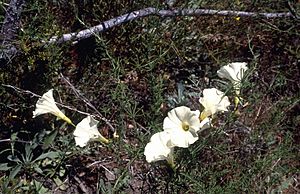Stebbins' false bindweed facts for kids
Quick facts for kids Stebbins' false bindweed |
|
|---|---|
 |
|
| Conservation status | |
| Scientific classification | |
| Genus: |
Calystegia
|
| Species: |
stebbinsii
|
Calystegia stebbinsii, also called Stebbins' false bindweed, is a very rare type of morning glory plant. It grows only in the Sierra Nevada foothills of California. You can find it in just two small areas in El Dorado and Nevada Counties. This plant lives in a special kind of environment called chaparral, where the soil is made of a rock called gabbro. Because it is so rare, the United States government lists it as an endangered species.
Contents
What Does Stebbins' False Bindweed Look Like?
Calystegia stebbinsii is a plant that lives for many years, which means it's a perennial herb. It has long, vine-like stems that can grow up to about one meter (about 3 feet) long. These stems are covered in soft, white hairs.
Its leaves are very special and help identify the plant easily. They are about 5 centimeters (2 inches) long and shaped like a hand with 7 to 9 long, narrow parts, almost like fingers.
Flowers and How They Grow
The plant's flowers grow on long stalks called peduncles. Each flower is about 3 centimeters (just over an inch) wide. They are usually white or creamy yellow, and sometimes have a hint of pink.
Bees and other insects help to pollinate these flowers. This means they carry pollen from one flower to another, helping the plant make seeds. Like many plants in the chaparral, Calystegia stebbinsii seeds need to be exposed to wildfire to start growing. The heat from the fire helps them germinate. The plant can also grow new plants from its underground stems, called rhizomes.
Why Is This Plant Endangered?
The first time this plant was officially collected and studied was in 1970 by a scientist named G. Ledyard Stebbins. It was found near Placerville, California. The plant was given its scientific name, Calystegia stebbinsii, in his honor in 1974.
This plant is only found in two main areas. Both of these areas are part of something called the Pine Hill intrusion. This is a place where magma (melted rock) pushed up from deep inside the Earth a long, long time ago. It then cooled and hardened into gabbro rock. Over time, the softer rocks around it wore away, leaving the gabbro exposed.
Special Soil and Habitat
The soil in these areas is reddish and has a lot of heavy metals. Some plants, like C. stebbinsii, are specially adapted to grow in this unique soil. It grows on both gabbro soil and a similar type of soil called serpentine soil, which is also found in this area. To help protect these rare plants, the Pine Hill Ecological Reserve was created.
When Calystegia stebbinsii was first put on the endangered species list, about one-third of the known plants had already been destroyed. This was mostly because people were building homes and other things where the plants lived. Many of the remaining plants were also in danger.
When their habitat is destroyed or broken into smaller pieces, other problems happen. These include building roads, dumping trash, using off-road vehicles, and spraying herbicides (chemicals that kill plants).
Fire and Survival
This plant does not like shade. If other bushes and trees grow too tall and block the sunlight, Calystegia stebbinsii cannot survive. This suggests that the plant needs natural events, like wildfires, to clear out the taller plants. When people try to stop all fires (this is called Fire suppression), it can actually hurt this plant. To help the plant, protected areas sometimes have controlled burns. These are fires that are carefully set and managed to clear out overgrowth, just like natural wildfires would.
See also
 In Spanish: Calystegia stebbinsii para niños
In Spanish: Calystegia stebbinsii para niños


